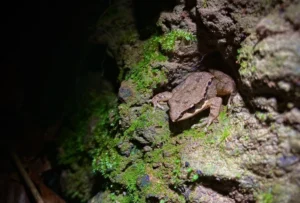Croaking is one of the most common noises frogs make. The typical loud croaking calls we hear from frogs are known as ‘advertisement calls’, and are used by frogs to advertise themselves as potential partners, for other frogs to mate with. But do female frogs croak?
In the vast majority of frog species, females lack or have only rudimentary vocal cords and do not make advertisement calls. The loud croaking you hear in the wet spring or summer months is almost always coming from male frogs trying to attract a female with whom to mate.
Females move towards calling males, and select the one they prefer based on their calls (and other factors).
Female frogs are generally considered to be the quieter sex. However, this is not to say that female frogs can’t make any noise – they certainly do.
Frog vocalization is not just used to attract a mate. Other types of vocalizations include territorial calls, release calls, distress calls, and warning calls.
In most species, only male frogs will make mating and territorial calls, but both males and females are capable of making release, distress, and warning calls.
How Frogs Croak
Frogs and toads have simple vocal cords that have two slits in the bottom of the mouth. They also have a vocal sac that can amplify the vibrations from the vocal cords.
When calling, a frog closes its mouth and nostrils, and expels air from its lungs through the vocal cords and into the vocal sacs. The vibrations of the vocal cords emits a sound – and the inflating and deflating vocal sac makes the sound louder or quieter.
By forcing air back and forth between their vocal sac and their lungs, the call becomes rhythmical.

The vocal sac is an elastic membrane of skin. It acts as a resonating chamber, causing the male toads’ mating call to be amplified and carried significant distances.
Most frogs have a single vocal sac under their throat, whereas other toads have the vocal sac on the corner of their mouth.
When a frog calls, the vocal sac will expand, but its mouth won’t open. Sometimes, it may look like the frog staring off while making the sound.
A male frog can croak individually, or a group of males may croak together in a chorus.
The Females of Most Frog Species Do Not Make Advertisement Calls
The females of most frog species lack or have only rudimentary vocal cords, and do not call to attract mates.
The typical loud calls (croaking) that we hear frogs make are known as advertisement calls- it’s male frogs advertising themselves as potential partners, hoping that female frogs will like their song and come their way.
These distinctive sounds range from high-pitched peeps to full-throated croaks.
Males usually call from ponds, swamps, streams, and other possible breeding sites. Each frog species has a different call and female frogs will only be attracted to the call of their own species
When females are ready to mate, they will move towards calling males, and pick the male that they prefer.
In some frog species such as the barking tree frog, most females will mate with the male closest to them. This is especially more likely when the distance to other calling males is large.
However, in many species, females can be much more selective. Some species prefer males who make their calls longer and more frequent – and other species prefer males who call next to a pre-made nest.
Sometimes, Male Frogs Croak to Defend Their Territory
In the mating season, male frogs often form temporary territories to attract females, which they defend from other males. These territories usually occupy the immediate area around an individual.
Breeding male frogs will defend the boundaries of their territories, and scare off other males by using a variety of calls. Some frogs will even fight intruding males.
Research has shown that male frogs of many species can tell the difference between their established neighbors, and unfamiliar strangers. This helps them avoid aggressive encounters with male frogs that hold territory nearby.
Female frogs choose their mates in part by the quality of their call, and their ability to defend their territory.
Female Frogs Are Capable of Making Other Vocalizations
Both territorial calls and mating calls are often classed as “advertisement calls”, letting other frogs know that they are present.
However, frogs can can make a variety of other sounds, for different functions.
1. Distress Calls
Many frog species can make “distress calls” when they are grasped by a predator. This call is usually a high-pitched scream that startles a predator causing it to release the frog, enabling the frog to escape.
2. Release Calls
Another type of vocalization is made by frogs that have been unwillingly grabbed by another frog searching for a mate, these are known as release calls.
When a male frog is try to mate, he may attempt to grab onto any frog that is close to him. If he grabs onto another male frog, a female that has already mated, or a frog of a different species, the grabbed frog will emit a release call – telling the offending male to let go.
The sound of the release call can be different depending on the frog species. In Green tree frogs (Hyla cinerea) the release call sounds somewhat similar to the soft clucking of a chicken. These calls are also sometimes made by the frog if it is being held too tightly in your hands.
3. Warning Calls
Another vocalization in some frog species is a “warning call”, a noise that is made by a frog that has been startled or disturbed. The frog may make a short squeak as it leaps away.
Like other frog vocalizations, warning calls can be different depending on the frog species.
In green frogs (Lithobates clamitans), the warning call is an abrupt iCUP! In American bullfrog (Lithobates catesbeianus), the warning call is a loud eeek!
The Females of a Few Frog Species Make Advertisement Calls
Female mating calls in frogs are rare. However, they have been observed in a number of species.
1. Concave-eared Torrent Frog (Odorrana tormota)

Concave-eared torrent frogs are native to China. These frogs’ preferred habitat is adjacent to rapidly moving water which produces perpetual background noise. This noisy habitat makes vocal communication difficult.
Male Concave-eared torrent frogs call to advertise their presence using calls with a high pitch and frequency.
In addition, on rainy nights prior to breeding, females emit ultrasonic calls from the sides of streams. These calls are of a higher frequency and are much shorter than the calls of males.
On hearing the call of a female, a male will make large hops toward the calling female with incredible acuity.
The female calls allow males to accurately detect females in a noisy environment.
Female Concave-eared torrent frogs have distinct vocal cords, which are bigger and thicker compared to those of the males.
2. Smooth Guardian Frog (Limnonectes palavanensis)

Smooth guardian frogs are found on the Palawan Island of the Philippines, and in Borneo (Brunei, Indonesia, Malaysia).
These frogs exhibit sex-role reversal, which means the males take the role that you usually see with females in other species.
Like other frogs, male Smooth guardian frogs make advertisement call. However, the males are often widely spaced, making them hard to locate.
For this reason, females give a loud call in response to a male advertisement call.
When females hear a male calling they will gather around the calling male, calling spontaneously at a higher frequency than the males.
Females may also initiate calling without a male calling first. When hearing this call, a male will produce a call that is different from the normal advertisement call, which helps the female in locating a receptive mate.
Researchers have hypothesized that since male Smooth guardian frogs provide all the parental care, the females take on many of the roles normally carried out by males in courtship; ie, frequent calling and seeking out mates.
3. African Clawed Frog (Xenopus laevis)

African clawed frogs are found throughout much of Sub-Saharan Africa. Like many other frogs, these frogs rely on auditory cues to locate and select a mate
It was previously thought that male African clawed frogs find females by producing advertisement calls at night to attract females – and females moved towards calling males.
However, scientists carried out research on the reproductive behavior of these frogs. It was found that female African clawed frogs swam directly towards a calling male and, on reaching him, produced an unusual rapping call consisting of a rapid series of clicks.
When a male heard the rapping call, he would intensify his calling and alter its structure, and would also move towards the female. This would lead to a unique duet of calls between the male and female.
This male-female duetting is very rare amongst amphibians and is more common in birds.
Commonly Asked Questions:
Do female frogs call? In most frog species, females lack or have only rudimentary vocal cords and do not make mating calls. However, in a few species such as the Concave-eared torrent frog of China, and the Smooth guardian frog of Borneo, female frogs call to attract mates.
Do female frogs have vocal sacs? In the majority of frog species, only males have vocal sacs. The vocal sac
acts as a resonating chamber, causing the male frog’s mating call to be amplified and carried significant distances. However, in a small number of species, both genders have vocal sacs
Do female frogs make noise? The females of most frog species do not make loud noise. The loud croaking you hear almost always comes from male frogs trying to attract a mate. The noises made by female frogs are usually soft and simple since females generally lack or have reduced vocal cords
Do female frogs make sounds? In most frog species, females do not make sounds to attract mates (advertisement calls) but are capable of making other sounds such as release, distress, and warning calls.
Featured image credit: Ignacio Ferre Pérez (CC BY-NC-ND 2.0)
Sources:
Erhard, H. C. (1994). The Evolution of Vocalization in Frogs and Toads. Annual Review of Ecology and Systematics, 25, 293–324. http://www.jstor.org/stable/2097314
Emerson SB, Boyd SK. Mating vocalizations of female frogs: control and evolutionary mechanisms. Brain Behav Evol. 1999;53(4):187-97. doi: 10.1159/000006594. PMID: 10343085.
Zhang F, Zhao J, Feng AS. Vocalizations of female frogs contain nonlinear characteristics and individual signatures. PLoS One. 2017 Mar 30;12(3):e0174815. doi: 10.1371/journal.pone.0174815. PMID: 28358859; PMCID: PMC5373630.
Hodl, Walter & Gollmann, Günter. (1986). Distress Calls in Neotropical Frogs. Amphibia-Reptilia. 7. 11-21. 10.1163/156853886X00226.
Kentwood D. Wells,Territoriality in the green frog (Rana clamitans): Vocalizations and agonistic behavior, Animal Behaviour,
Volume 26, Part 4, 1978, Pages 1051-1063, ISSN 0003-3472, https://doi.org/10.1016/0003-3472(78)90094-5.
Feng, A., Narins, P., Xu, CH. et al. Ultrasonic communication in frogs. Nature 440, 333–336 (2006). https://doi.org/10.1038/nature04416
Feng AS, Narins PM. Ultrasonic communication in concave-eared torrent frogs (Amolops tormotus). J Comp Physiol A Neuroethol Sens Neural Behav Physiol. 2008 Feb;194(2):159-67. doi: 10.1007/s00359-007-0267-1. Epub 2008 Jan 29. PMID: 18228079.
Vallejos, Johana. (2016). Parental Care and Acoustic Communication of the Smooth Guardian Frog Limnonectes palavanensis, a Bornean Frog With Possible Sex-Role Reversal.
Tobias ML, Viswanathan SS, Kelley DB. Rapping, a female receptive call, initiates male-female duets in the South African clawed frog. Proc Natl Acad Sci U S A. 1998 Feb17;95(4):1870-5. doi: 10.1073/pnas.95.4.1870. PMID: 9465109; PMCID: PMC19205.


